Let’s take a look at some peas and beans that are available this season, “in the pod”, and an idea or two about what to do with them.
Green Peas – These are what most of us think of as the common green pea, sweet pea, or the English pea. When I was growing up they came frozen in butter sauce in a bag which one dumped unceremoniously in boiling water and left to cook until lovely and hot. They were all uniformly the same size, roundness, green color, texture, etc., etc. Variation wasn’t allowed, the Jolly Green guy took care of that, if not the dove of peace or whatever it was that “the other company” used as a logo. But those peas, presumably, started out the same way as these – in a pod. Each pod is anywhere, generally, from 2-4″ long and contains somewhere between, say, 1 and 10 peas. They are not uniformly the same size, roundness, green color, texture, or anything else. They’re not loosely rolling about in there, though it often seems that way when split open – each pea has a little stem connecting it to the lifeline of the pod.
The pods themselves are not really edible – you could, but it wouldn’t be a pleasant experience. Mostly they’re used for cattle fodder, or thrown out. The peas are relatively hard, and I’d highly recommend at least blanching and shocking them before eating. Which is what we do, also encouraging the development of a vivid green color. Then we saute them with finely diced red onion, salt and pepper, in olive oil. When cooked through we remove the pan from the heat and toss in a handful of whole hierbabuena leaves, a local mint, and any mint is really fine, and thinly sliced aji limo chilies. Meanwhile, of course, we’ve made and cooked up a batch of homemade semolina pappardelle, tossed the pasta with olive oil, and then we top it with the pea medley, and grated gran pampeano cheese, the local paean to grana padano (you could also use parmigiano, romano, pecorino or any other good, hard grating cheese).
Snowpeas, here called Chauchas Japonés, sometimes called Chinese Pea Pods or Japanese Snowpeas, are a mild type of pea. The entire pod is edible, not just the pea inside, though it’s best to remove the stem end and the stringy fiber that runs down the inner curve (bend back the stem and pull gently and it will almost always pull away with the whole string).
I’m just going to share my favorite Shanghai style dish from our Eastern Region Chinese cooking class. This isn’t my personal recipe, it’s a classic! This is the recipe from the class notes:
“Velveting” – coating chicken or fish in a mix of egg whites, cornstarch and seasoning, then cooking gently in oil until it just turns white, setting it aside and finishing cooking it later with other ingredients.
“Creamed” Chicken with Mushrooms, Ham and Snowpeas
185 gm chicken breast, chopped
60 gm snowpeas, pea sprouts, bean sprouts, or spinach
60 gm mushrooms, finely sliced (canned are fine, and enokii, or straw mushrooms are common)
30 gm ham, sliced the same size as the mushrooms
360 ml of frying oil + 1½ teaspoons rendered chicken or duck fat (optional)Seasoning A:
2 egg whites, beaten
¼ teaspoon salt
¼ teaspoon sugar
½ teaspoon msg, optional
½ teaspoon rice or sherry wine
1 tablespoon onion-ginger infusion (boil 3 chopped green onions and some ginger slices in ½ cup water, strain and store)
2 tablespoons cold waterSeasoning B:
80 ml chicken stock
¼ teaspoon salt
½ teaspoon msg, optional
¼ teaspoon sugar
½ teaspoon rice or sherry wine
½ teaspoon cornstarchMix the chicken with seasoning A ingredients, stirring steadily for 5 minutes to make a smooth paste. Heat oil to moderate in wok or frying pan and add the chicken. Cook gently until it just turns white, about 1½ minutes. Transfer to strainer to let drain. Pour off all but 2 tablespoons of oil and saute the vegetables, mushrooms and ham on high heat for 2 minutes. Add seasoning B ingredients, pre-mixed, and bring to a boil. Reduce heat and simmer 2 minutes, put the chicken back in and heat through, stirring constantly. Add the chicken fat and transfer to serving plate.
Broad Beans (Green Fava Beans) (here called Habas) – Basically looking like giant lima beans, these take a bit more work to prepare. Neither the pod, nor the peel of the beans is really edible – they’re not poisonous or anything, they’re just fibrous and chewy and not very pleasant. So the first thing is to open the pods and take out the beans – although for photo purposes I sort of stripped off one side of the pod, the way I really do it is just work my way down the pod, breaking it open in between each bean and squeezing them out – it goes really quickly that way. One thing to note, there’s no consistency to content – sometimes a pod will only have one or two beans, sometimes five or six.
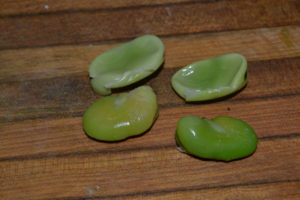
You can peel the skins off the beans while raw, but bluntly, it’s a pain the butt, because they’re tough. You’re probably not going to eat the beans raw anyway, so the easiest thing is to bring a pot of water to a boil, dump the beans in, bring it back to a boil, and I find that letting them boil for about 3-4 minutes is just about right. Strain them off, run them under cold water to cool them enough to handle, and then pop the insides out – sometimes the skins will have split open and make that really easy, sometimes you have to create a little tear with your thumbnail and then pop them out.
The beans are now cooked enough to use in something like a salad, or you can cook them more if you want to make something like soup or a puree – like the Sopa de Habas that I covered in my last Ingredients 101 post, or the broad bean hummus to accompany roasted quail. We love them in salad-y kind of things. Recently I mentioned Solterito con Langostinos, in talking about using Chinese Black Vinegar.
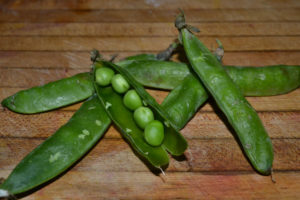
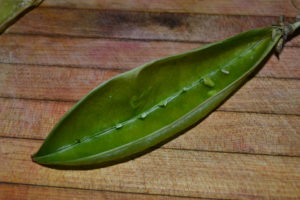
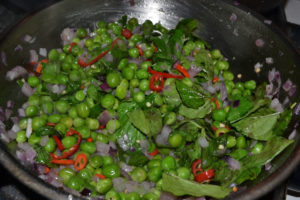
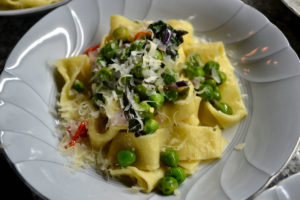
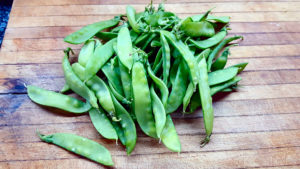
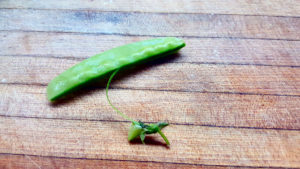
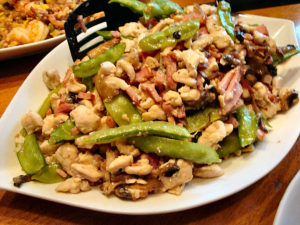
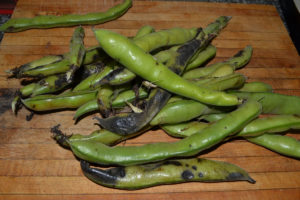
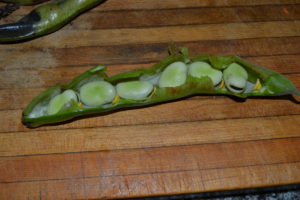
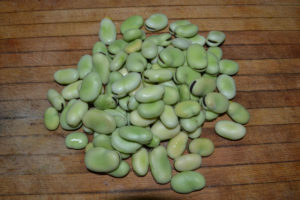
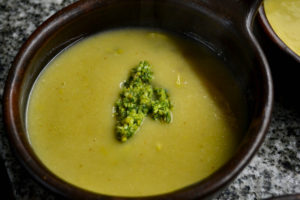
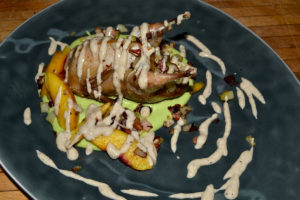
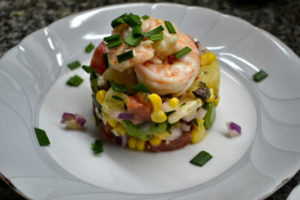
[…] pool of the sauce, some red quinua seasoned simply with salt and pepper and a little butter, fresh broad beans, diced orange segments, pitted black olives, the orange peel (remove white pith, cut in thin […]
[…] huacatay, garlic, onion, fresh homemade cheese (not by us, by someone out at the Liniers markets), parboiled and peeled broad beans; then coming back the other way… parboiled corn on the cob (10 minutes in water with a little […]